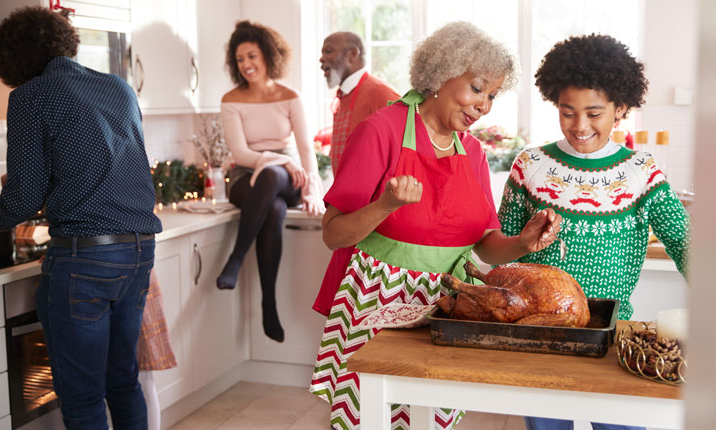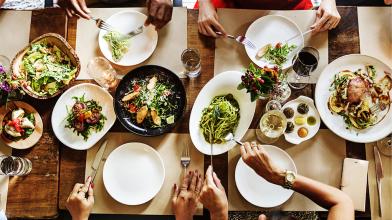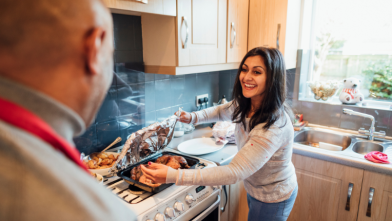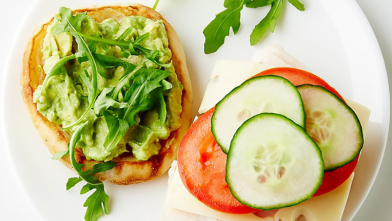From the flood of fun-sized candies on Halloween to the candy hearts on Valentine’s Day, and all the holiday feasts in between, winter can be a minefield of food temptations. If you’ve recently been diagnosed with diabetes, you may be feeling overwhelmed, anxious, and uncertain about how to manage your diabetes during the holidays. To provide a little guidance, we've asked diabetes and nutrition experts to share their top tips for staying on track this holiday season without sacrificing holiday cheer!
Be Ready and Plan for Challenges
"This season is full of special events, from office potlucks, to baking cookies with the kids, to formal dinners in fancy restaurants. Take inventory of all of your upcoming obligations and holiday events, and what challenges might come up at each one.
Decide in advance which of these events is worthy of indulging (I know that I’d rather treat myself at certain events than others) and think of ways to manage some of the challenges you anticipate. Being prepared for challenging situations will make it easier to stay on track."
–Jill Weisenberger, MS, RDN, CDE, CHWC, FAND, author of Prediabetes: A Complete Guide. Find her on the web at jillweisenberger.com
Eat Breakfast!
"It may be tempting to skip your morning meal in order to plan for a festive meal later in the day. However, skipping breakfast can leave you feeling over-hungry at meal time, which leads to over-eating. This may more than make up for the calories you skipped in the morning. And, more importantly, skipping meals can lead to extreme highs and lows in your blood sugar, including a blood sugar spike after that festive meal.
To prevent cravings and overeating later in the day, start your day with something light, like this Herbed Soft Scrambled Eggs on Toast."
–Jackie Newgent, RDN, CDN, author of the forthcoming The Clean & Simple Diabetes Cookbook. Find her on the web at jackienewgent.com
Be Physically Active
"With all the food being served during the holidays, many people forget to move around. Start a new tradition that involves physical activity away from the food. For example, before Thanksgiving many towns hold a “turkey trot”—a race or long walk that usually takes place on Thursday morning.
You can get the whole family and even the neighbors involved in activities like a friendly game of touch football, soccer, or Frisbee. It can also be as simple as a family walk around the neighborhood."
–Toby Amidor, MS, RD, CDN, FAND, author of the forthcoming The Create-Your-Plate Diabetes Cookbook. Find her on the web at tobyamidornutrition.com
Gather Information
"Managing diabetes is a constant learning process, and there is plenty you can learn over the holidays! Tracking information will help you understand how your body responds to different factors. Food journals, exercise logs, blood glucose records, and medication monitoring are all important aspects of managing diabetes. Gathering this information will give both you and your healthcare providers the tools needed to adapt and adjust your diabetes care plan to achieve success."
–Lori Zanini, RD, CDE, creator of www.ForTheLoveOfDiabetes.com
Don’t Beat Yourself Up
"The holidays are a hard time for anyone to stick to healthy habits, and it can be especially challenging if you’re learning to manage a new diabetes diagnosis. Some days will be better than others—the important thing is to not beat yourself up for going off your meal plan one day. You can always get back on track the day after the holiday gathering. And don’t forget to give yourself credit for what you’re doing well!"
–Shelby Kinnaird, creator of www.diabeticfoodie.com
Take Something Healthy to Share
"If you are concerned that the food at a holiday gathering won't fit your meal plan, then consider bringing a healthier dish to share that suits your preferences and needs. That way you’ll know there’s at least one item you can enjoy without worry. And chances are your host will welcome an addition to the party spread.
You can browse Diabetes Food Hub to find diabetes-friendly recipes for appetizers, snacks, and entertaining."
–Tami Ross, RD, LD, CDE, MLDE, author of What Do I Eat Now? Find her on the web at www.tamirossrd.com
Be a Picky Eater
"The typical holiday feast is usually pretty abundant in carb-rich choices, which can leave you with too much on your plate. Pick and choose only what you really love, or what is special this time of year. For example, the Thanksgiving table can include a lot of high-carb choices—mashed potatoes, sweet potatoes, stuffing, corn, rolls, pie. Let yourself indulge in the foods that are most special, and skip the rest."
–Katie Morford, MS, RD, creator of www.momskitchenhandbook.com
Drink Responsibly
"The holidays are a time to be together with friends and family, and that will usually involve alcohol. While a moderate amount of alcohol (1–2 drinks per day) is perfectly fine for people with diabetes, be careful of overindulging and be aware of safety concerns while drinking with diabetes. For example, drinking can increase your risk of hypoglycemia.
Alcoholic drinks can also add a lot of calories and carbs to your meal. Choose drinks that are naturally lower in calories and don’t have added sugars. For example, a glass of wine only has only 4 grams of carbohydrate and about 120 calories, while a regular margarita can have up to 30 grams of carbs and around 230 calories!
–Marina Chaparro, MPH, RD, CDE, founder of nutrichicos.com
Enlist Support
"Identify at least one person that you can rely on for support and accountability throughout the holiday season. It can be a healthcare provider, spouse, family member, coworker, friend...anyone you trust. Share with them in advance how they can support you, check in on you, and help you meet your goals throughout your first holiday season living with diabetes."
–Lori Zanini, RD, CDE, creator of www.ForTheLoveOfDiabetes.com
Follow the Plate Method
"Finding the right balance can be tricky when faced with a large holiday spread, but use your (9-inch) plate to help guide your portions. First, fill half your plate with non-starchy vegetables like spinach, carrots, brussels sprouts, broccoli, etc. Now you have another half to customize. Fill one quarter of your plate with lean protein and leave the last quarter of your plate for carb foods, such as corn, breads, mashed potatoes, fruit, or dessert. This is an easy way to build a balanced plate without spending time counting carbs or having to pass up your favorite foods."
–Shamera Robinson, MPH, RDE, CDE, Associate Director of Nutrition, American Diabetes Association








